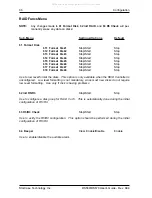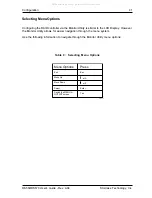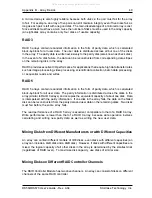
48
Appendix B - Array Basics
StorCase Technology, Inc.
DS560/DS570 User's Guide - Rev. A04
Appendix B - Array Basics
The SCSI-IDE RAID Controller allows the set up and management of disk arrays. A disk array
is a group of disks that appears to the system as a single virtual disk. This is accomplished
through software contained in the RAID controller. RAID (Redundant Array of Independent
Disks) refers to disk arrays in which part of the array storage capacity may be used to store
redundant information. The redundant information allows the restoration of user data if a disk
in the array fails.
The host system views the controller as a single SCSI disk drive. It is actually an array of
physical disks behind a RAID controller (it is managed by software to appear as a single
physical disk). Depending on the array type, the virtual disk has advantages in fault-tolerance,
cost, performance, or a combination of these.
Array Types
Array types are defined by their RAID level, a number from 0 through 5 (a higher RAID level
does not necessarily indicate a higher level of performance or fault-tolerance). The RAID
Controller allows the user to create the types of arrays proven to be the most useful for RAID
applications: RAID 0, 1, 0/1 (also known as mirrored or RAID 10), 3, and 5.
RAID 0 (Striped Disks)
In a RAID 0 array, data is distributed (also known as striped) across the disks in the array.
The array appears to the server as one large disk with a capacity approximately equal to the
combined capacity of the physical disks. Because multiple reads and writes can be handled
in parallel, the input/output performance of the array is much better than that of a single physical
disk.
RAID 0 arrays do not store redundant data, so they are not true RAID applications. If one disk
fails, the entire array fails and all array data is lost. The fault-tolerance of a RAID 0 is less than
that of any single disk in the array. The term RAID 0 is widely used for these arrays however,
because they are conceptually similar to true RAID applications.
RAID 1, 0/1, and 10 (Mirrored Disks)
In RAID 1, RAID 0/1, and RAID 10 arrays (commonly referred to as mirrored arrays), disks are
paired, with both disks in the pair containing the same data. When data is written to a mirrored
array, it is written twice - once to each disk in the pair. A RAID 1 array has only one set of
paired disks. A RAID 10 array has multiple pairs, across which data is striped.
The read performance of RAID 1 arrays can be much greater than that of a single disk, while
the write performance is slightly lower. In RAID 1/10 arrays, both read performance and write
performance are better than those of a single disk.
All manuals and user guides at all-guides.com











































